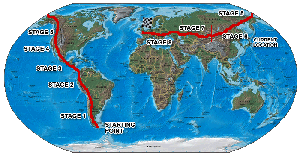Well this is the day before my big move from San Diego back home to Vancouver. I’ve been a little swamped with packing up the house, and trying to finish up a number of projects here. I do seem to move a lot–5 cities in as many years. Hopefully I’ll get a chance to kick back and relax when I get to Van.
… later that day …
So the house is pretty much all packed up. Most of the stuff is already on the truck, and the last big things will go on in the morning. Its quiet and echo-y in here. The shrill laptop key-clicks remind me just how empty this space is, and I find myself rummaging through memories of past moves. Curiously they have all taken place at about the same time of year–perhaps I’m just following some sort of reptilian annual migration.
All of my prior moves felt like the beginning of some kind of adventure. They all had a crisp scariness to them. This one feels more like an end. It feels like an end to the firey wanderlust I’ve had since about 17 when I decided I wanted to move to the other side of the world. I wasn’t really running away–I was running to–to what I still don’t know, but that probably isn’t the point.
I think this one will be the last, and its a little sad because there are so many places I never a got a chance to live in: anywhere in England or Japan, Paris or Helsinki, Budapest or Sao Paulo. Sure I can always visit, but I’m a terrible tourist. I need to live, pay rent, shop, eat, do laundry, slowly get soaked up by the daily rhythms of local life. I once spent a month in Rome doing nothing but mundane living among the ruins, and it was one of the best trips I’ve ever had.
Perhaps I’m on the edge of what is just a different kind of adventure; but something feels a bit less adventurous about it. Don’t get me wrong, there are few places in this world I’d rather live in than Vancouver. I feel an intense personal affection for that city such that living anywhere else again would feel adulterous. I guess I’m just a bit sad to watch the embers cool.






